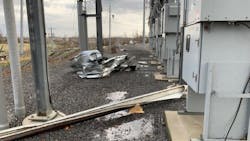Kentucky Utility Uses Past Lessons to Prepare for Tornado
A split second: That’s all it takes for calm to turn into calamity. On December 10, 2021, residents of Mayfield, Kentucky settled into their homes, unaware of the destruction headed their way. In just three minutes, a devastating tornado touched down, claiming 22 lives and leveling nearly 500 homes and businesses. Weather emergencies are uncontrollable and, often, unpredictable. That’s why preparation is key.
Mayfield Electric & Water Systems is no stranger to the uncertain nature of weather emergencies. A 2009 ice storm left 10,000 people without power. The city of Mayfield found itself without an outage restoration plan and no way to communicate with staff. Just 12 years later, lessons learned from that moment were put to the test.
General Superintendent of Mayfield Electric & Water Systems Marty Ivy created an emergency preparedness plan following the city’s recovery from the ice storm. According to Ivy, this resource proved invaluable when he and his team faced devastation in the aftermath of the 2021 tornado.
He implemented the utility’s emergency preparedness plan to kickstart Mayfield’s recovery effort. This started with ensuring that all employees and their families were accounted for and relocated to hotels in neighboring communities where they had electricity, running water and a temporary home.
The next step was to evaluate the damage to the utility’s equipment. Their main office was struck, computers and servers destroyed and the fleet of bucket and digger trucks completely wiped out. In total, the City of Mayfield suffered $45 million worth of damage. With a call for help, utilities, providers and volunteers from across the country gathered to rebuild the community, piece by piece.
“It all happened so quickly,” said Ivy. “On Friday, we had a company of 42 employees. On Monday, we had 250 people helping us. From linemen to water operators and pipe fitters, people from all over the Tennessee Valley and Kentucky were there to pitch in.”
Xylem engineers evaluated Mayfield’s equipment and kept the Sensus FlexNet communication network connected to electricity and water meters while other employees participated in the massive cleanup effort. Xylem also partnered with Americares to set up a charitable campaign that yielded $28,000 in relief funds.
The tornado destroyed the water distribution warehouse along with hundreds of homes and businesses. Despite the devastation, Mayfield’s water system was fully operational within 30 hours of the violent storm and advanced metering infrastructure helped speed up leak detection and repairs.
“Everyone in the utility industry helps each other out,” said Ivy. “One of the first groups to call and offer support was Xylem’s Sensus. We’ve been a Sensus customer for 12 years now, and I consider them my friends.”
Along with the help of their neighbors, Ivy attributes Mayfield’s resiliency to having a plan in place and the use of the utility’s advanced metering infrastructure (AMI) system.
“It’s invaluable to have an AMI system,” said Ivy. “We used ours to export visual graphs of our electric restoration progress. Knowledge is power, and we used this information to understand our remaining workload and to share status reports with the community.”
Within 30 hours, Mayfield’s water system was fully operational and pressurized. The AMI system helped speed up the team’s response to repair leaks in the tornado zone so they could tackle the biggest water issues first.
The neighboring service provider, West Kentucky Rural Electric Cooperative Corporation, pitched in to assist and just five days after the disaster, Mayfield had three circuits operational and restored power to the local hospital. By day seven, the substation was back online, and within one month, all power was restored to customers who could be reconnected to the grid.
